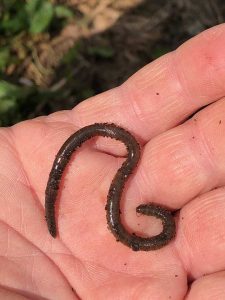Real Can of Worms
Non-native earthworms threaten forest health.

 One might say I opened a can of worms when I promised to embark on a story about earthworms in North America. My discussion in last week’s story of the eastern mole who can eat its weight in worms daily prompted this topic. The mole also bites the worms’ heads off, rendering them immobile, in order to cache its quarry in an underground storage chamber to consume at a later time. More than 400 headless worms have been discovered in these chambers in some instances.
One might say I opened a can of worms when I promised to embark on a story about earthworms in North America. My discussion in last week’s story of the eastern mole who can eat its weight in worms daily prompted this topic. The mole also bites the worms’ heads off, rendering them immobile, in order to cache its quarry in an underground storage chamber to consume at a later time. More than 400 headless worms have been discovered in these chambers in some instances.
So if you grew up learning that earthworms were the cat’s meow and moles were a neighborhood pest, prepare to have your bubble burst. Like mute swans, night crawlers are exotic invasive species and ecologists are not fond of either. And with good reason.
I was naïve to the exotic earthworm invasion of North America until a trip to Minnesota in 2018. There is actually an organization called Great Lakes Worm Watch that is educating people about taking care not to introduce earthworms because they change the ecology of an environment.
Experts in soil biology and farming generally speak of worms in glowing terms. Conversely, forest biologists describe invasive worms as destroying the rich carpet of organic matter on the forest floor of the Northeastern United States. They have drastically changed the soil by consuming the leaf litter and leaf mold that native oaks and forest plants need. Earthworms accelerate the decomposition that would normally be accomplished much more slowly by fungi and bacteria; these create a duff layer important to new growth and spring flowers, and it is an essential blanket in cold weather.
Worse yet, the compositional changes caused by worms support invasive plants, allowing them in many cases to outcompete natives. Prairie ecologists explain that since the 1850s Euro-American settlers have imported trees and earthworms not native to North America, thus changing the makeup of forest and prairie soils.
In the Northeastern United States any earthworms north of the glacial boundary are undoubtedly exotic. Soil scientists hypothesize that native species were extirpated during the glacial period. The glaciers’ southern boundary was in central New Jersey and the sands of the coastal plain where we live in southern New Jersey are the scourings of the glacial front. Most of the worms we are familiar with in our gardens—primarily night crawlers, or Lumbricus terrestris—were never found naturally in North America. They are invasive species, introduced by European settlers.
Farmers and the U.S. Department of Agriculture actively dispense information about the virtues of earthworms in the agriculture system because their burrowing creates holes that accelerate the movement of water in soils and help with aeration and decompaction of soils. They are major decomposers of organic matter, deriving nutrition from fungi and bacteria present on the leaf litter. However forest ecologists have a very different view of our wiggly subterranean denizens.
Peter M. Groffman, a senior scientist at the Institute of Ecosystem Studies, Millbrook, NY, explained to Ira Flatow on National Public Radio’s Talk of the Nation, “Sometimes we might find actually more water-quality problems in gardens or in agricultural systems because earthworms are accelerating the way water and nutrients move through the system.” Regarding decompaction of soils Groffman offered, “Yes, they do [aerate soils]. But the soil’s probably pretty well aerated anyway. Certainly if we have soils that are compacted, say, that have seen a lot of traffic, people walking on them or driving on them. [In] compacted soils, earthworms can have a very beneficial effect by aerating the soil.”
But his real concern is for forests where soils are naturally well-aerated and worms are playing an adverse role in the ecosystem. When water is moving more swiftly through the soil profile into our aquifer without the slower filtration necessary to reduce pollutants, then our drinking water quality can be negatively affected. And important moisture is not retained in the duff layer.
Groffman continued to explain that forests without worms have very thick layers of organic material that support native plants like spring beauty, trillium, and trout lily, and an animal community of salamanders, beetles and insects. But where earthworms are present these species disappeared, a process that took place in as little as three to five years! Worms also caused changes to the forest’s version of the world wide web—the mycorrhizal fungi layer beneath the forest floor, which enables chemical communications between trees and plants.
At CU Maurice River we take field trips to see the spring ephemerals in Maryland and Pennsylvania and we are not the only group to make this trek. People are in awe of these lovely blooms. Forests without the early spring appearance of native plants would be heart-wrenching.
On the other hand some animals, like robins, are thought to be more abundant because of earthworms. The American lawn creates an artificial habitat that supports a glut of these members of the thrush family. Although they are native, in disproportionate numbers they too cause imbalances in the natural world.
So what about areas south of the Great Ice Age’s movement some 2.6 million years ago? Are there indigenous worms there? Groffman says they see very few native species because they have been outcompeted by those from Europe and Asia.
Worms do have great value in the compost pile in breaking down organics that are placed there. And when soils are compacted they surely play a role. Additionally there is a commercial industry in worms for bait and farming purposes. You can find reams of information on their beneficial uses especially in supporting the exotic food that we grow. But our point here is that the proliferation of exotic worms is wreaking havoc on our forest and prairie ecosystems. And scientists are debating whether the role they have played in gardening is as beneficial as was once believed.
So let’s bring this topic full circle: The moles that Americans think of as little terrorists are eating worms that are a scourge to our ecosystems. Possibly an attitude adjustment is in order as we reevaluate our ideas about both moles and worms. Which is really the evildoer? n
To gain a greater understanding of worms and forest health visit the University of Minnesota’s Natural Resources Research Institute, Great Lake Worm Watch’s website as well as the following sources:
Science Friday – Talk of the Nation, Interview with Peter M. Groffman
Natural Resources Conservation Service – earthworm and soil, Clive Edwards, Ohio State University
U.S. Department of Agriculture fact sheets
Research University of Minnesota









